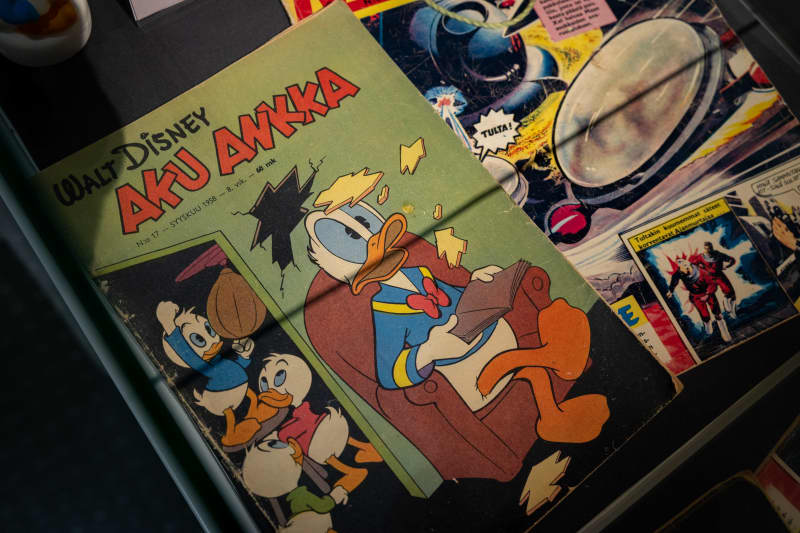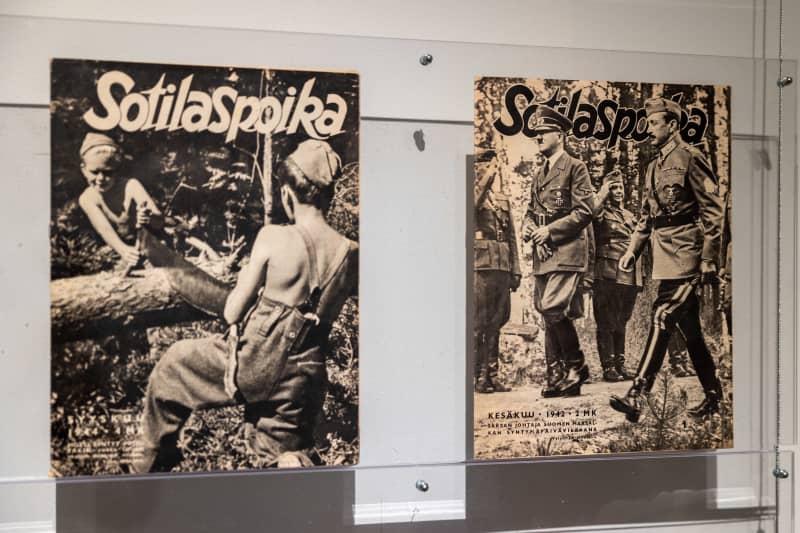The Postal Museum’s exhibition Kind Children’s Magazines reflects the ideal values of adults. In the early decades of independent Finland, children were expected to be hard-working and respect their country.
– The first grade teacher handed out the *Aku Ankka* reading charts to us students. They were accompanied by a subscription coupon and of course we had to get the magazine,” says Elkelä.
*Aku Ankka* started appearing in Finland in 1951 and represented a new culture for children and young people. It was international, American-oriented and colourful. In fact, it was with Aku and other cartoons that the golden age of Finnish children’s magazines came to an end. Times were already different from when grandfather used to flip through *Pääskynen*.

Kari Elkelä has collected tens of thousands of magazines and is now focusing on researching and organising them in his retirement. The collector has an old storage shed in Sahalahti, where he now has a stack of leaves and collectibles with his sons. There are more than 20 000 leaves alone.
Home, religion and country and a little bit of Finland’s beautiful nature
The *Kiltit lastenlehdet* exhibition starts from the early years of the 20th century. In young Finland, children wanted to be raised to be happy woodworkers, decent citizens.
According to Elkelä, after independence, hard work and sobriety began to be emphasized in newspapers.
– The early children’s magazines were entirely made by adults, Elkelä reminds.

The magazines present the children as sweet, hard-working helpers of mother and father, unsparing companions and gold nuggets who rely on God.
Gender roles are stable. The girls smile with bows on their heads and the boys slide down the hill with their ski caps on.
It was hoped that the magazines would lead young people to good hobbies and household chores, because of course the young people already knew how to play malex, water magazines and laze around fluently.
In the early years of independence, magazines were often modest in appearance. According to Elkelä, the same cover image could be used in up to ten magazines in a row. All major publishing houses made their own magazines for children. In addition, there was a wide field of organizations and member magazines of the organizations.
The colourful covers of Christmas magazines enchanted
Both artists were known especially for their Christmas imagery. Christmas magazines aimed at children were more wonderful than everyday publications.
– The Christmas magazines mainly had fairy tale content. There was usually at least one religious story in the group, says Elkelä.

The visual world seen by children was still quite colorless and scarce long after the wars. Only a few had colorful toys, beautiful clothes and richly decorated homes. Mostly only the wealthy townspeople could go to the movies or the theater.
The magical cover pictures of the Christmas magazines and, for example, the Glossy pictures were treasures.
Hitler marches on the cover of a children’s magazine
Major societal changes were inevitably also reflected in publications aimed at children. During the war, children were often harnessed to work as laborers, and the organizations organizing laborers also published magazines to encourage and involve younger people.
Both Suojeluskunta and Lotta Svärd had their own magazines for young people. On the cover of the *Sotilaspoika* magazine on display at Postimuseo, Mannerheim and Hitler are wearing boots.
– At that time, it was such a media event that it was in all newspapers, including those aimed at children, says Kari Elkelä, referring to Hitler’s visit to Mannerheim’s 75th anniversary on June 4, 1942.

After the wars, the children’s world gradually became less carefree. In children’s magazines, cute and colorful animal figures were running wild. *The student* encouraged information seeking and playing quizzes.
A large part of children’s magazines withered due to a lack of buyers and subscribers.
For *Aku, Tex* and *Korkeajannitys*, for example, *Nasta*, which also published cartoons, also made a splash. The magazine encouraged its readers to establish their own small Nasta clubs. The youth were not encouraged to go wild in their clubs.
Kari Elkelä says that his wife founded a club called Nasta-pimut as a teenager.
– However, it did not go through the magazine’s editors. They suggested a more conventional name for the farm, like Nasta-tytöt, Elkelä laughs.
Today, children’s magazines are dominated by *Koululainen*, which began to appear in 1945. The paper version is still published once a month.
The Kind Children’s Magazines exhibition is open at the Vapriik Postal Museum until March 5.
